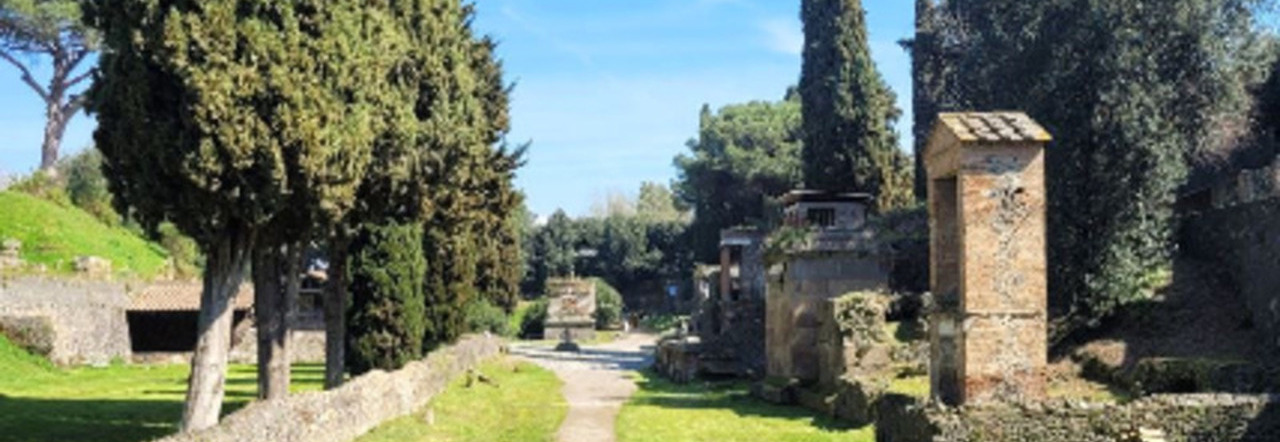Pompeii: The Sacred and Compassionate Display of Eruption Victims

Thursday 28 March 2024, 14:43 - Last updated :
29 March, 12:01
3 Minutes of Reading
From the entrance of Piazza Anfiteatro, walking through the green path flanked by the ancient tombs of the Porta Nocera necropolis, one arrives at a unique place that, like others in Pompeii, is filled with sacredness and compassion. It is the exhibition area of some casts of victims of the eruption, found near the ancient Porta di Nocera. From today, the group of casts, after maintenance and restoration operations, are once again accessible thanks to the interventions for the adjustment and enhancement of the visit path that allows approaching the exhibition area. From here, it is possible to contemplate the details of what, only apparently are plaster forms, but to a careful look correspond to how the writer Luigi Settembrini in the 1800s more properly described them: 'They have been dead for eighteen centuries, but they are human beings seen in their agony. There is no art, no imitation, but their bones, the relics of their flesh and clothes mixed with plaster: it is the pain of death that regains body and shape...'
The area of Porta Nocera, with its necropolis, develops outside the city walls, to the southwest of the ancient city of Pompeii. The urban gate opened in the direction of the ancient city of Nuceria (where today the current municipalities of Nocera Inferiore and Nocera Superiore are located). The entire area was brought to light during the excavations conducted in May 1952, by the then director of excavations Amedeo Maiuri as part of a much broader program that aimed to free the entire city wall from much of the backfill that still covered it.
In the autumn of 1956, during the arrangement of the excavation fronts, in the area between the street of the tombs and the city walls, a group of four victims and the remains of a structure for muliones (muleteers) were found in the north-western sector. As was already ordinary practice at the time, casts of these victims were made, according to the technique developed by the archaeologist Giuseppe Fiorelli in the 1800s. The method, still used today, consists of pouring liquid plaster into the cavities found in the hardened ash bed, where archaeologists identify voids caused by the decomposition of organic soft parts. Once the plaster has dried, the volume, shape, and position of the object or body buried there are returned as a mold.
Of the 4 casts of the victims, only one lies in the original position of discovery. It is an adult man, about 1.80 m tall in a prone position with spread legs, covered on the back by a tunic. The cast was left in its original position directly on the lapilli. Two other victims were found not far away, between Porta Nocera and tower II of the fortification: a teenager lying on his left side, legs bent forward with traces of a tunic on his back and abdomen and the soles of the sandals; and an adult lying on his right side with arms and legs bent, traces of the tunic and the sole of the left sandal.
The last cast of this group was a boy aged between 7 and 19 years, initially interpreted by Maiuri as an elderly man, lying on his right side, retaining the imprint of a thin fabric on the chin, while at his feet he wore sandals with laces. The traces in the cast of a stick, a wooden bowl, and a satchel, readable in a swelling on the left side of the victim, led to the belief that he was a beggar.
The maintenance and care interventions of the group of casts of Porta Nocera aimed to make the exhibition area accessible to the public for a new valorization of one of the historical arrangements made by Maiuri. The activities particularly concerned the creation of a safe access to the site, a reorganization of the exhibition space with the insertion of new iron balustrades and the lightening of the existing protection panels by removing the grates that constituted a visual limitation of the works, of the panels only the metal frame was left adapted to the housing of new ultra-clear and safety glass elements, for a better perception of the whole and the details of the bodies, up to the maintenance of the existing coverings.
© ALL RIGHTS RESERVED
This article is automatically translated
This article is automatically translated
